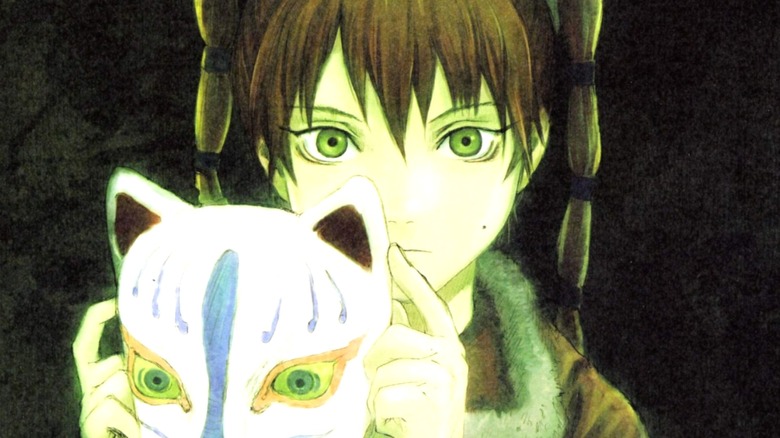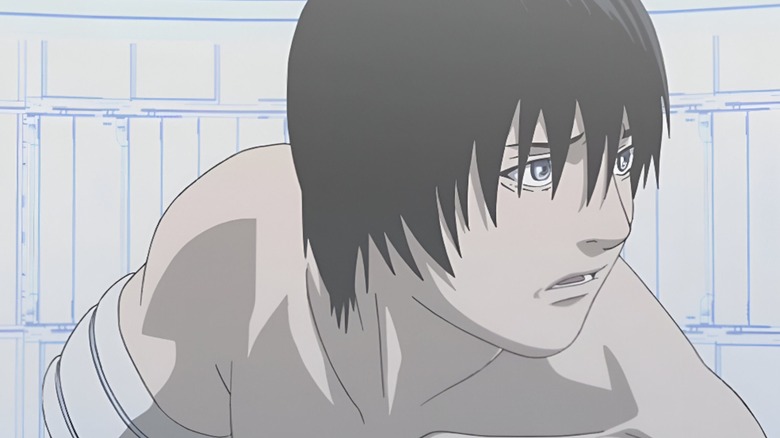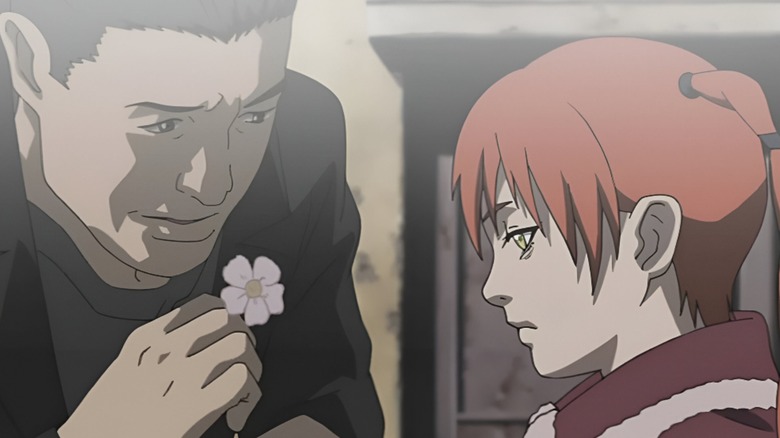Cyberpunk Fans Will Love This Criminally Overlooked Sci-Fi Anime Series
This post contains major spoilers for "Texhnolyze."
The world of cyberpunk anime is vast and promises distinct stories. There are foundational genre titles like "Akira" and "Ghost in the Shell," along with underrated entries like "Blame!" or "Akudama Drive" (that have covertly shaped our understanding of cyberpunk over the decades). But cyberpunk also houses experimental anime in the same vein as "Serial Experiments Lain," which promises a grim, mind-bending sci-fi tale about the horrors of being an adolescent girl in a world rapidly overtaken by corrosive cyberspace. Chiaki J Konaka, who wrote "Lain" and fleshed out its philosophical vignettes, also penned a lesser-known spiritual successor steeped in nihilism and a thousand ethical dilemmas. This overlooked gem is none other than "Texhnolyze," which Konaka made in collaboration with producer Yasuyuki Ueda and legendary character designer Yoshitoshi ABe (who also worked on "Lain").
Calling "Texhnolyze" a cult hit is an understatement. It is one of those dystopian stories that constantly defies straightforward analysis and boasts a close-knit community of fans eager to dissect its complex core. One of the reasons why "Texhnolyze" eludes mainstream appreciation is its overwhelmingly bleak overtones, compounded by the fact that it is experimental in the truest sense of the term. The series' first episode itself functions as a sort of litmus test, as it relies exclusively on frenetic symbolism and visual imagery to convey its themes, utilizing minimal dialogue to spell out its premise. While some might find this alienating, "Texhnolyze" puts immense faith in the viewer to meet it halfway — an impulse that pays off by the time the story hurtles towards its nihilistic conclusion.
Once you're able to grasp what Konaka is going for, "Texhnolyze" blossoms into a topical and prescient cyberpunk tale that anticipates the genre's defining characteristics, including the chaos inherent in a cybernetic arms race and shifting definitions of humanity that come with it. Without further ado, let's descend into the cold, apathetic world of "Texhnolyze," whose eccentric essence is conveyed through a banger opening theme by Juno Reactor.
Texhnolyze is an uncomfortably honest examination of identity in a dystopian world
Director Hiroshi Hamasaki (who served as key animator for the "STEINS; GATE" anime and its companion film) plunges us into this fictional world by creating a rousing visual landscape where every micro-detail matters. For example, we do not learn the name of our boxer protagonist, Ichise, until the third episode, and our initial impression of him is purely cobbled together through his actions (as opposed to his words, since he rarely speaks).
As we watch Ichise stumble through a dilapidated bathroom while (silently) reminiscing about a violent boxing match, we immediately grasp his helplessness, even though we do not understand it yet. Throughout the initial episodes, Ichise is treated like cattle, as if he has already lost his chance at claiming humanity due to his socioeconomic status. An orphan forced into doing the bidding of those who "own" him, Ichise barely reacts to the violence inflicted on him, as he has internalized that resistance is futile amid such a cruel society.
But Ichise is a fighter. He swings his punches on instinct, and the boxing matches he's forced to fight in for survival have unwittingly shaped his borderline-animalistic sense of emotionality. The reactions to his surroundings are detached and visceral at once, which explains why he launches into agonized fits of rage when provoked and pushed into uncomfortable situations. So when a powerful member of society assaults him with obvious glee, he instinctively fights back to protect himself. But there is a price to pay for such perceived transgressions, leading up to one of the most disturbingly horrific scenes in anime: Ichise is hunted down in the crumbling alleyways of Lux, where one of his arms and legs are viciously cut off to remind him that he can never be seen as human.
As Ichise drags his dismembered limbs with him through the apathetic city, "Texhnolyze" makes it clear that empathy is a defunct sentiment in Lux, where it's every man for himself. Actually, it's worse — this is a society where only the powerful and opportunistic prevail, as anyone unfortunate enough to suffer becomes a prime target for exploitation. After Ichise is granted a second chance at life with the titular texhnolyzation process (similar to getting cybernetic implants, but much more morally dubious), this rebirth is less of a miracle and more of a cruel play by fate, which remains indifferent to individual suffering.
Texhnolyze champions a distinctly brilliant brand of cyberpunk worldbuilding
There's more to "Texhnolyze" than Ichise's disorienting, heartbreaking arc. For starters, lawless conflicts take place between the city's various factions, which include the mafia-esque Organo, the cult-like Salvation Union, and the rebellious youth gang, Racan. Amid these ideological clashes, some stand out as anomalous figures, such as the prophetic child Ran, who dons a kitsune mask to shield her big, evocative eyes (which seem to pierce through the fabric of the foreboding landscape).
Ran's elusive presence is as confusing as the fast-paced imagery that facilitates a slow-burn worldbuilding, as it takes considerable time to piece together the fact that Lux is an underground city, and that those who live above ground are unknown variables in this puzzling equation. There's also Yoshii, the mysterious visitor from the world above, who imbues the series' grim outlook with a charismatic spirit that hits us like a breath of fresh, crisp air.
The series' visual identity is hard to put into words, as it feels like a cold, impersonal portrayal of a city that must've been a bustling metropolis at one point in history, but is now as ruined as its collapsed social structure. Here, people barely give in to passion or sincere expressions of human connection, which is why the few instances that do embrace these sentiments feel almost transgressive.
For instance, the quiet affection between Organo boss Onishi and his loyal assistant Michiko emerges as a tender declaration of humanity, even though both characters are drenched in the most cruel acts of extreme violence. It is also worth noting is none of this violence is gratuitous or indulgent — even when blood gushes out like a fountain or bodies are pierced by a hail of bullets, the framing is matter-of-fact, just like the harsh reality of Lux being utterly devoid of hope.
For some, "Texhnolyze" might be hard to stomach, much like the traumatizing saga of "Neon Genesis Evangelion," which embeds slivers of hope within an overarchingly bleak story about self-acceptance. However, just like "Evangelion," it holds a unique mastery over visual/narrative storytelling, as it challenges our expectations of what a thematically dark, character-driven anime should be like. If you give "Texhnolyze" a chance, you might stumble upon a sense of haunting beauty in the crumbling depths of Lux, which tells its layered secrets only to those willing to stop and listen.


